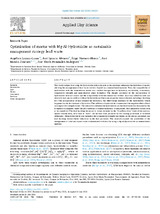Optimisation of mortar with Mg-Al-Hydrotalcite as sustainable management strategy lead waste
Autor
Lozano Lunar, Angélica
Álvarez, José Ignacio
Navarro-Blasco, Íñigo
Jiménez, José Ramón
Fernández Rodríguez, José María
Editor
MDPIFecha
2021Materia
HydrotalciteLead
Mortar
Calorimetry
Leaching
Waste management
METS:
Mostrar el registro METSPREMIS:
Mostrar el registro PREMISMetadatos
Mostrar el registro completo del ítemResumen
This study analyses how a Mg-Al-Hydrotalcite with carbonate in the interlayer influences the hydration of mortar allowing the management of lead waste (solid or liquid) in a cement-based material. First, the compatibility of hydrotalcite with the cementitious matrix was studied through heat of hydration, workability, consistency, compressive strength and mineralogical phase formation. The changes produced by the incorporation of hydrotalcite were not drastic and the compatibility with the cement was verified. Lead was added in oxide and nitrate form to mortar with or without hydrotalcite and the same properties were evaluated, including a leaching test. The incorporation of lead delayed the hydration, this effect being increased by the hydrotalcite, which happened in the first instants of hydration. The addition of hydrotalcite counteracted the negative effect of lead in compressive strength values. The interaction between the hydrotalcite and the lead waste was favoured by the formation of plumbites under the pH conditions of cement hydration. Consequently, this interaction would seem to be superficial. The lead leaching decreased to values included in the “Non-Hazardous” limit of the environmental classification, very close to “Inert”. All mortars were produced by two mixing procedures to establish differences. When hydrotalcite was included, the compressive strength was higher in the second procedure and lead leaching showed better behaviour in the first procedure. This research expands the possibilities of the management of solid and liquid waste contaminated with lead by using a Mg-Al-Hydrotalcite in cement-based matrices.

